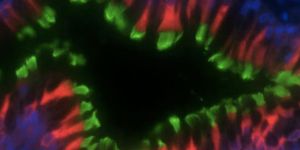A Botulinum Toxin Jumped to a new Species of Bacteria
Bacteria live everywhere in our environment and even inside of us, and the vast majority of them are harmless. A common type is Enterococci, which are well adapted to live many places, including hospitals. That natural adaptability has made them ideal candidates for carrying drug resistance genes and developing into pathogens capable of causing severe infections. Researchers assaying a farm in South Carolina have now identified a strain of Enterococcus that harbors a toxin similar to botulism. The findings have been reported in Cell Host & Microbe.
"This is the first time a botulinum neurotoxin has been found outside of Clostridium botulinum -- and not just the toxin, but an entire unit containing the toxin and associated proteins that prevent the toxin from being degraded in the GI tract," explained botulism expert Min Dong, of Boston Children's Hospital's Department of Urology and Harvard Medical School.
The novel toxin has been dubbed BoNT/En and it’s the ninth botulinum toxin to be described. "The enterococcal isolate carrying the toxin luckily remains susceptible to key antibiotics," noted study co-author Sicai Zhang, a postdoctoral fellow in Dong's lab. "It was found only once from a single animal, and no signs of botulism disease were observed."
The researchers also found that rodents were not affected by the toxin. It had an impact only after the scientists modified it. It is now being tested in human neurons in culture to assess any potential effects.
The toxin BoNT/En genes were found to be carried on what is called a plasmid, enabling them to jump to a new species. Plasmids are mobile genetic elements that often move to new species; they often carry antibiotic resistance genes. It unfortunately now looks like toxin genes can also move around, possibly into a drug-resistant strain of E. faecium .
"Enterococcus is a central hub for gene transfer within the gut, and that makes it potentially scary," said Dong.
This strain of E. faecium was sequenced as part of a larger search for the origins of the pathogenicity and antibiotic-resistance of Enterococcus.
"We were not looking for a neurotoxin in E. faecium," said co-author Francois Lebreton, who examines microbial genomes. "There was no reason to suspect its existence." Lebreton studies enterococci evolution from its Paleozoic origins to modern hospital pathogen.
"In intensive agriculture, antibiotics are administered to farm animals to promote weight gain in often crowded facilities. We believe that this creates an environment in the animal gut that allows antibiotic-resistant enterococci to thrive and come into contact with humans," he explained. "We know that the highly antibiotic-resistant E. faecium strain we fight in the hospital is very closely related to strains found in the GI tracts of farm-raised animals."
Bioinformatics helped answer some questions. After assessing the new E. faecium genomic sequence, the lab of bioinformatician Andrew Doxey zeroed in on the novel botulinum toxin sequence.
"The way that we discovered this toxin using computational methods is different from how toxins used to be identified in the past and may become a standard approach in biomonitoring," said Doxey. "It represents scientific collaboration and data sharing at its best."
There is now some concern that antibiotic-resistant Enterococci might combine with botulinum toxin. Such a mashup could happen in the gut of an animal harboring both microbes.
"This is a unique discovery of a botulinum neurotoxin in a bacterium that is both ubiquitous in animals and a serious problem in human health," noted Lebreton. "E. faecium is in the gut of nearly every human; it is extremely tough and survives a lot of stresses, often including efforts to disinfect hospital surfaces. A hospital-adapted, antibiotic-resistant, hard-to-kill bug carrying a neurotoxin would be a worst-case scenario."
The animal that might be infected by the ninth botulinum toxin is not yet known. The labs are continuing their studies. "Most of what we know about Enterococcus comes from the few strains circulating in the hospital," said Lebreton. "It's possible that BoNT/En, or even other novel toxins, will turn up in other enterococci isolated from the wild. We just never looked for those before."
What is botulism? The video above answers that question.
Sources: AAAS/Eurekalert! Via Boston’s Children’s Hospital, Cell Host & Microbe










